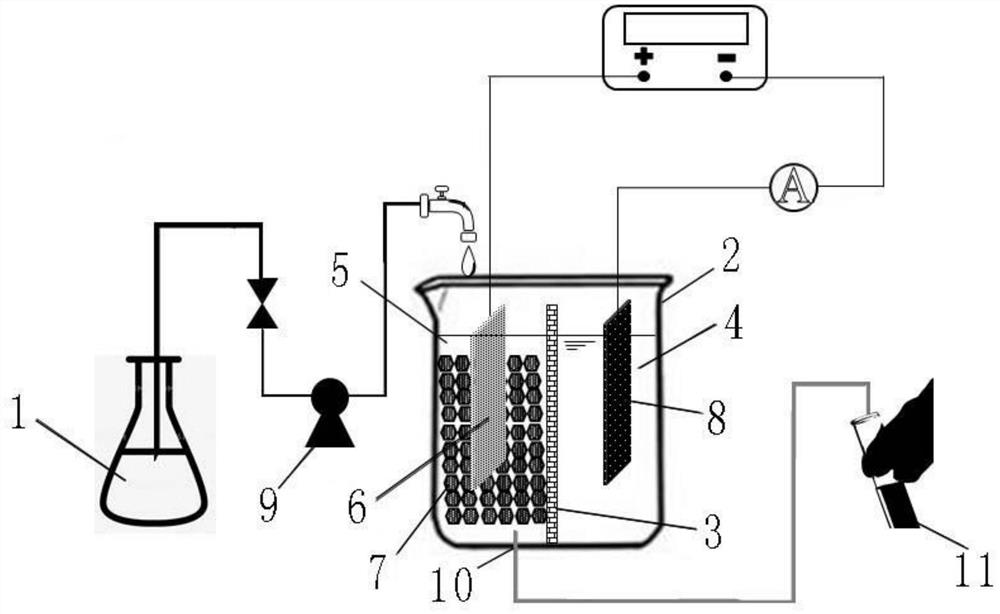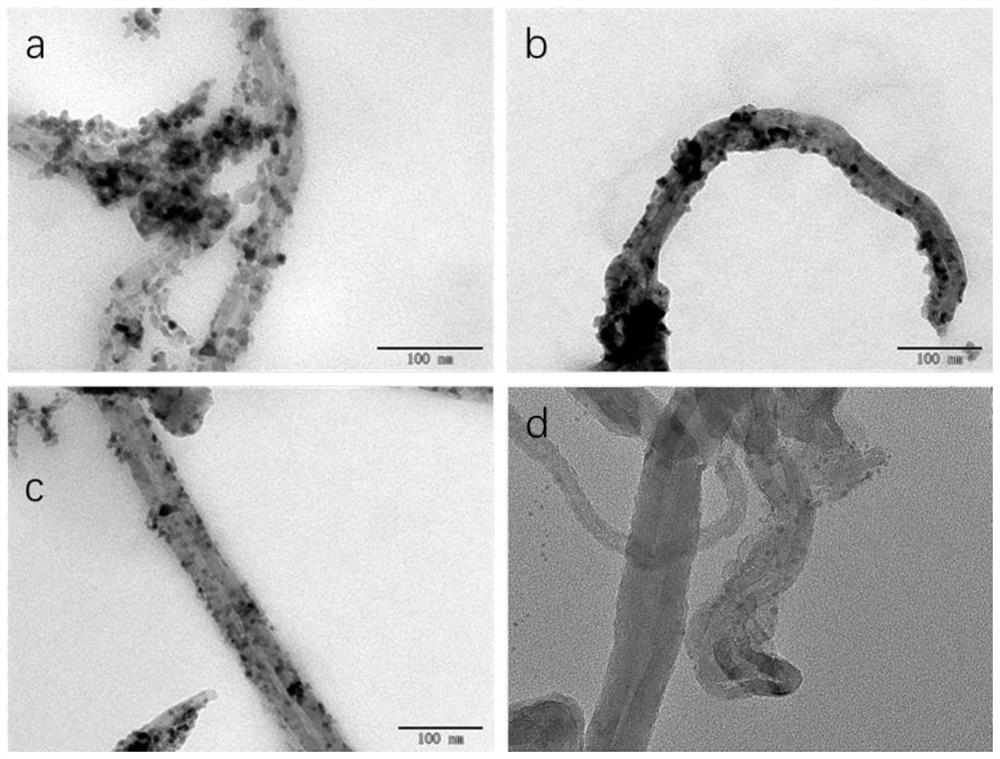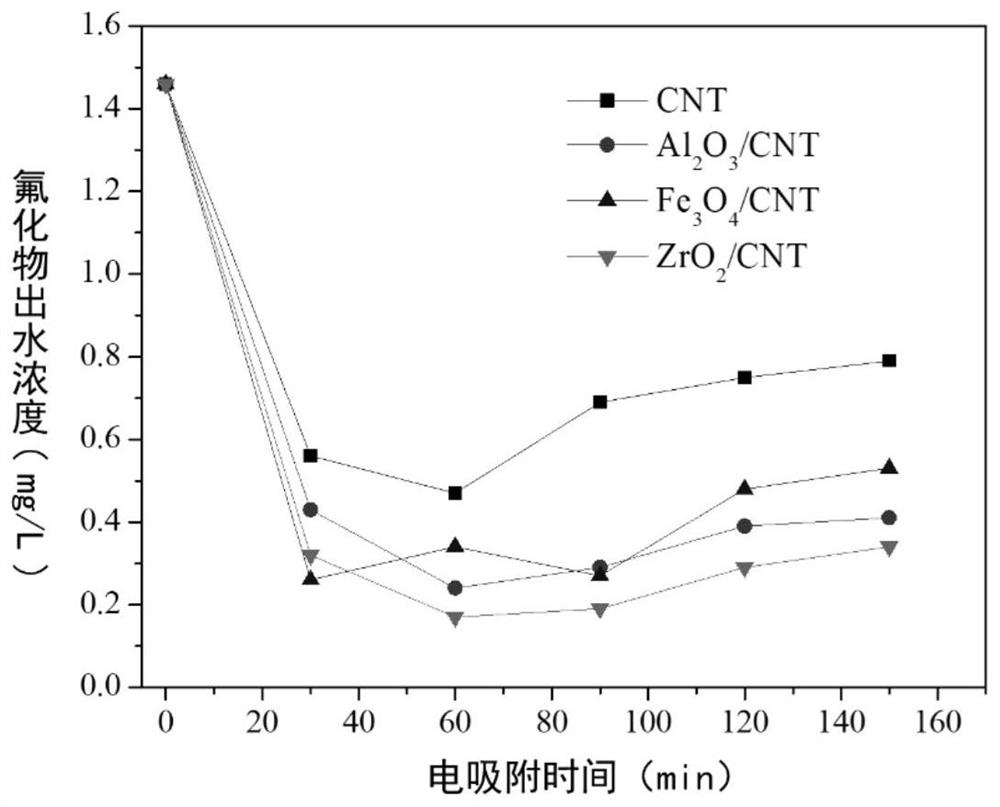A process for defluoridation of surface water based on carbon nanotube three-dimensional electrode
A technology of carbon nanotubes and three-dimensional electrodes, which is applied in the direction of water pollutants, water/sewage treatment, water/sewage treatment equipment, etc., can solve the problems of secondary pollution of water bodies and ineffective removal of fluoride, and achieve stable removal, Good chemical stability, high conductivity effect
- Summary
- Abstract
- Description
- Claims
- Application Information
AI Technical Summary
Problems solved by technology
Method used
Image
Examples
Embodiment 1
[0060] A method for preparing a fluoride adsorption three-dimensional electrode, comprising the following steps:
[0061] S101, preparing powdered carbon nanotubes;
[0062] S102, using the powdered carbon nanotubes prepared in S1 to prepare sheet electrodes;
[0063] S103, preparing a carbon nanotube three-dimensional electrode material.
[0064] Further, the specific operation of said S101 is:
[0065] Heating nitric acid to 100°C-110°C, mixing with industrial grade carbon nanotubes to remove impurities;
[0066] Washing the carbon nanotubes with distilled water until the pH of the washed water is neutral;
[0067] Place it in an oven at 80°C for 12 hours, take it out and grind it into powder for later use.
[0068] Further, the purity of the nitric acid is 60%, and the purity of the industrial-grade carbon nanotubes is 98%.
[0069] Further, the specific operation of S102 is: mix 0.45-0.55g of carbon nanotubes with 15-25mL of ethanol, add 0.15-0.25mL of 75% PTFE soluti...
Embodiment 2
[0075] This embodiment is described on the basis of the above-mentioned embodiment 1, and the similarities with the above-mentioned embodiment 1 will not be repeated.
[0076] In the process of preparing powdered carbon nanotubes in this example, nitric acid was heated to 105°C, and the purity of industrial grade carbon nanotubes was 98%;
[0077] When preparing sheet electrodes, mix 0.5 g of powdered carbon nanotubes with 20 mL of ethanol, add 0.2 mL of 75% PTFE solution, and ultrasonicate for 30 minutes.
Embodiment 3
[0079] This embodiment is described on the basis of the foregoing embodiment 1 or 2, and the similarities with the foregoing embodiments will not be repeated.
[0080] This embodiment mainly introduces the use of Al on the surface of carbon nanotubes 2 o 3 Modification is carried out to increase the adsorption capacity of the three-dimensional electrode for fluoride.
[0081] The method for modifying the surface of carbon nanotubes with metal oxides specifically includes:
[0082] Mix 0.6g of carbon nanotubes with 0.004-0.006 moles of Al 2 (NO 3 ) 3 9H 2 O was dissolved in 50 mL of ethylene glycol, ultrasonicated for 1 h, and magnetically stirred for 8-12 h; then, calcined at 500 °C for 2 h in a tube furnace under a nitrogen atmosphere to prepare Al 2 o 3 Modified carbon nanotubes, wherein the ratio of metal / carbon atoms is 10% to 15%.
[0083] The beneficial effect that this embodiment obtains:
[0084] This embodiment introduces metal oxide-modified carbon nanotubes...
PUM
| Property | Measurement | Unit |
|---|---|---|
| length | aaaaa | aaaaa |
| particle diameter | aaaaa | aaaaa |
Abstract
Description
Claims
Application Information
 Login to View More
Login to View More - R&D Engineer
- R&D Manager
- IP Professional
- Industry Leading Data Capabilities
- Powerful AI technology
- Patent DNA Extraction
Browse by: Latest US Patents, China's latest patents, Technical Efficacy Thesaurus, Application Domain, Technology Topic, Popular Technical Reports.
© 2024 PatSnap. All rights reserved.Legal|Privacy policy|Modern Slavery Act Transparency Statement|Sitemap|About US| Contact US: help@patsnap.com










